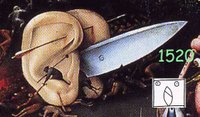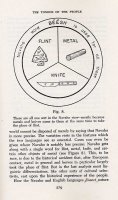

The mnemonic/translation for 2-Flint/
ome tecpatl in
The Garden of Delights/El Jardín de las Delicias is a European style knife. It might have been confusing for Spanish speakers that the word
tecpatl can mean flint (
pedernal), a knife (
cuchillo), or a day or year, but not extremely confusing since there are flint knives in the Bible. The problem seems to be that whereas in a European language “flint knife” only calls to mind a vague image since knives are no longer made of flint, a
tecpatl or a picture of one sometimes had a face with eyes and teeth, and looked like a fish when turned sideways. A translation into Nahuatl would have had to go from a fairly neutral word to one loaded with unknown connotations. The image in
The Garden of Delights/El Jardín de las Delicias translating the glyph
tecpatl to a picture of a knife is relatively simple.

On the other hand in the twentieth century the anthropologist Clyde Kluckhorn found the idea of using the same Navajo word for an old arrowhead, a new knife, and metal complicated enough to warrant a diagram with both words and pictures. (The page shown here is from the 1974 paperback edition of
The Navaho.)

 The mnemonic/translation for 2-Flint/ome tecpatl in The Garden of Delights/El Jardín de las Delicias is a European style knife. It might have been confusing for Spanish speakers that the word tecpatl can mean flint (pedernal), a knife (cuchillo), or a day or year, but not extremely confusing since there are flint knives in the Bible. The problem seems to be that whereas in a European language “flint knife” only calls to mind a vague image since knives are no longer made of flint, a tecpatl or a picture of one sometimes had a face with eyes and teeth, and looked like a fish when turned sideways. A translation into Nahuatl would have had to go from a fairly neutral word to one loaded with unknown connotations. The image in The Garden of Delights/El Jardín de las Delicias translating the glyph tecpatl to a picture of a knife is relatively simple.
The mnemonic/translation for 2-Flint/ome tecpatl in The Garden of Delights/El Jardín de las Delicias is a European style knife. It might have been confusing for Spanish speakers that the word tecpatl can mean flint (pedernal), a knife (cuchillo), or a day or year, but not extremely confusing since there are flint knives in the Bible. The problem seems to be that whereas in a European language “flint knife” only calls to mind a vague image since knives are no longer made of flint, a tecpatl or a picture of one sometimes had a face with eyes and teeth, and looked like a fish when turned sideways. A translation into Nahuatl would have had to go from a fairly neutral word to one loaded with unknown connotations. The image in The Garden of Delights/El Jardín de las Delicias translating the glyph tecpatl to a picture of a knife is relatively simple. On the other hand in the twentieth century the anthropologist Clyde Kluckhorn found the idea of using the same Navajo word for an old arrowhead, a new knife, and metal complicated enough to warrant a diagram with both words and pictures. (The page shown here is from the 1974 paperback edition of The Navaho.)
On the other hand in the twentieth century the anthropologist Clyde Kluckhorn found the idea of using the same Navajo word for an old arrowhead, a new knife, and metal complicated enough to warrant a diagram with both words and pictures. (The page shown here is from the 1974 paperback edition of The Navaho.)


0 Comments:
Post a Comment
<< Home